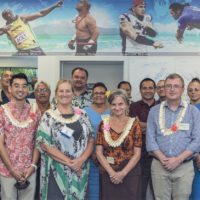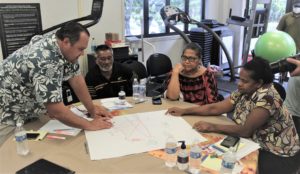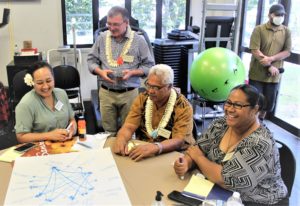
Childhood obesity was the focus of a special workshop held recently by the Agriculture, Community and Natural Resources (ACNR) Division of the American Samoa Community College.
Representatives from Children’s Healthy Living (CHL) Center for Excellence at the University of Hawaii at Manoa, along with a specialist in the strategic practice of group model building from Case Western University in Cleveland, Ohio, facilitated.
Dr. Rachel Novotny and Dr. Jean Butel, both familiar faces from previous visits to American Samoa and ACNR, along with meeting recorder Mr. Jordon Oshiro, represented the CHL; while Dr. Peter Hovmand from Case Western University guided the actual model-building process along with ACNR staff.
Dr. Rachel Novotny gave an overview of the CHL, whose mission is to address the causes of childhood obesity and other health-related concerns, and work with communities in the US Affiliated Pacific region to create an environment that promotes and sustains healthier lifestyles. 
A challenge such as the rise in childhood obesity, Dr. Novotny explained, is the result of multiple factors, including the prevailing social, cultural, economic and logistical conditions in any given community. The strategy of group model building represents a “big picture” approach by gathering as many of these factors as possible, and analyzing how they affect child diet and health.
With the workshop participants organized into groups, each wrote down their own list of factors they could think of—which influence dietary health for better or worse. For the second “Graphs Over Time”, each group chose a factor from their list that can change over time, and created a graph based on this dynamic. The third stage consisted of the groups creating “Connection Circles”, which illustrated how one factor connected with one or more other factors. The final stage was “Action Ideas”, where the groups considered the time element and connections they had previously identified, and whether these suggested actions could cause positive changes.
In this procedure, the initial “prototype” model is a visual rendering of how factors relate, and how modifying one can cause changes in another. In this instance, the challenge is childhood diet and obesity, and it is the aim of the workshop facilitators and ACNR that this strategy-building technique can assist the local public and private agencies in their own efforts to address the overall health of the community—in general and children in particular.
The CHL plans to make funding available to organizations and/or individuals with projects that support the Center’s goals. A Request for Proposals will be made available in May for people to apply for CHL funding, to design new innovative programs that address food system resiliency and child health; redesign existing programs to connect food system resiliency and child health; and/or develop skills to measure food systems and health programs.
Aside from ACNR staff, participants from the government and private sector were from the Department of Health (DOH), the DOH Community Health Center, the Early Childhood Education Program, the Department of Education School Lunch Program, the Department of Human and Social Services – WIC, and the Centers for Disease Control and Prevention (CDC), along with private sector business Tutuila Green Ltd.




